Subjects:
- General info about the disc brake
- Disc brake versions (fixed & floating caliper)
- Carbon ceramic brakes
- Ventilated and perforated brake discs
- Release the blocks
- Measuring brake disc thickness
- Curved brake disc
- Measuring the brake disc runout
General info about the disc brake:
The disc brake disc is mounted between the hub and the rim. The brake disc always rotates with the wheel. Brake pads are placed on both sides of the brake disc. When braking, the brake linings are pressed against the disc, so that the rotational speed of the brake disc decreases. The friction between the brake lining and the brake disc generates heat.
The image shows an overview of the disc brake. The moment the brakes are applied, the brake fluid be pressed into the large space (indicated in yellow) behind the brake piston via the brake hose. Because brake fluid is not compressible, the pressure build-up will cause the brake piston to move out. At that moment the brake pad is pressed against the brake disc.
The brake caliper in the picture is of the “floating type”. This means that the caliper can slide back and forth via guide pins, because there is only one caliper piston. The following section describes the differences between a floating and fixed caliper.
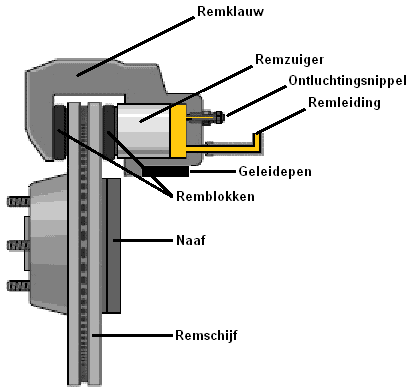
Disc brake versions:
Disc brakes can be equipped with a floating or a fixed caliper. This section describes the operation of both types.
Disc brake with floating caliper:
With a floating caliper, the brake works with one caliper. When braking, the piston first presses the inner brake pad (on the brake piston side) against the brake disc. This will cause the brake caliper to shift to the right. This is made possible by the two guide pins that the caliper can slide over. Because the brake caliper slides over the guide pin during braking, the outer brake pad is also pushed against the disc. The disadvantage of the floating caliper is that the inner brake pad often wears faster than the outer, because the outer is often pressed against the brake disc with less force. That is why it is always very important to look especially at the inner brake pad during a check. Where the outer brake pad is 5 mm, the inner brake pad can be 3 mm.

Disc brake with fixed caliper:
With this construction, there are two caliper pistons in the caliper, one on each side of the disc. The brake caliper is mounted on the steering knuckle and does not move when the brake is applied, as is the case with the floating caliper. When the brake pedal is actuated, the brake fluid presses against both brake pistons. The advantage of this system is that both brake pads are pressed against the brake disc with the same force.
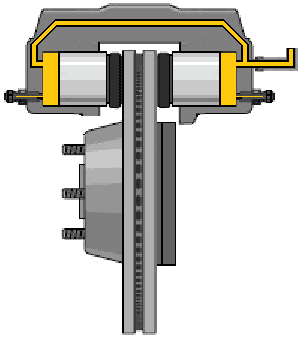
Carbon ceramic brakes:
With the conventional brake discs, the temperature can rise very high during prolonged, vigorous braking. This can result in brake fading which reduces the braking power. This is especially a problem in racing and sports cars.
For this reason, car manufacturers increasingly use carbon ceramic brakes from 2000 onwards. The temperature of carbon ceramic brake discs also becomes very high (maximum 1350°C), but at high temperatures the frictional properties remain stable. There is therefore no brake fading at high temperatures.
The braking effect is optimal when the brakes are warmed up.
The material of these brake discs is very hard. As a result, the brake discs last much longer than conventional brake discs. Care must be taken when disassembling / assembling, for example, the wheels; bumping the wheel against the brake disc can easily damage the brake discs.
Another advantage of carbon ceramic brake discs over conventional brake discs is a low weight. A carbon ceramic brake disc weighs up to 70% less than a “normal” brake disc. This benefits the unsprung mass, which people want to keep as low as possible for optimum driving characteristics of the car.
The disadvantage of this type of brake disc is the price; the additional cost of ceramic brakes on a new car can amount to more than ten thousand euros.
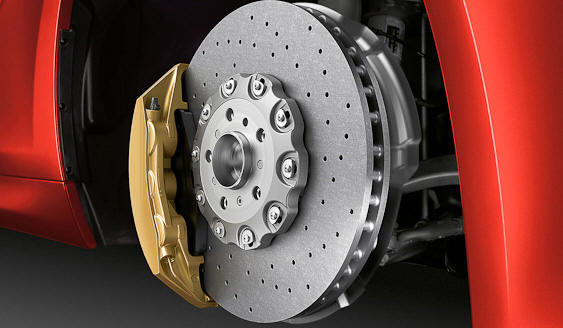
Ventilated and perforated brake discs:
The illustration shows brake discs that are both ventilated and perforated. The openings in the brake discs allow air to flow through them, allowing the brake discs to cool down more quickly after braking.
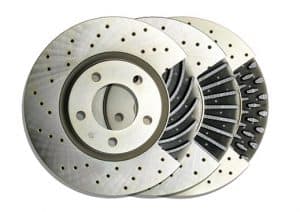
Release the blocks:
When braking is stopped, the brake pads should be released from the brake disc. Around the brake piston is a rubber ring (number 4 in the picture below) which ensures the seal between the piston and brake cylinder. The ring deforms during braking. When the brake pedal is released, the rubber ring returns to its original shape. The piston is pulled back slightly, releasing the blocks from the disc. With this construction there is almost always some play between the brake pad and disc. As the brake pads wear, the piston will move in the rubber ring.
The dust cover is indicated by number 1. The dust cover prevents moisture and dirt from getting into the caliper and brake fluid from leaking out of the caliper.
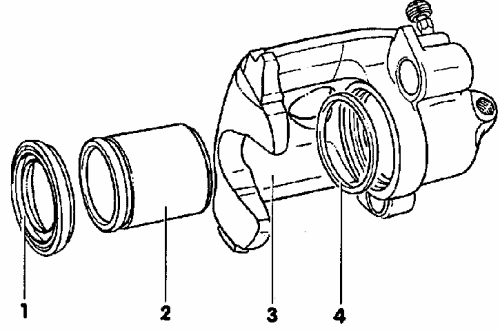
Measuring brake disc thickness:
Brake discs always wear out with use and last one or two sets of brake pads. The brake disc becomes thinner with wear. Car manufacturers set a limit to the extent to which a brake disc may be worn. This is stated in the vehicle documentation as “minimum brake disc thickness”.
The thickness of the brake discs can be determined with a special brake disc thickness caliper. Measuring the brake disc thickness cannot be done with a normal caliper be carried out, because the normal caliper has flat measuring jaws and therefore measures the thickness of the (rust) edges on the brake disc. That is not the intention, because people are only interested in the thickness at which the brake pads wear on the disc. With a caliper for the brake disc, the contact surface where the brake pad touches the brake disc is measured. This can be seen in the image below and is explained below.
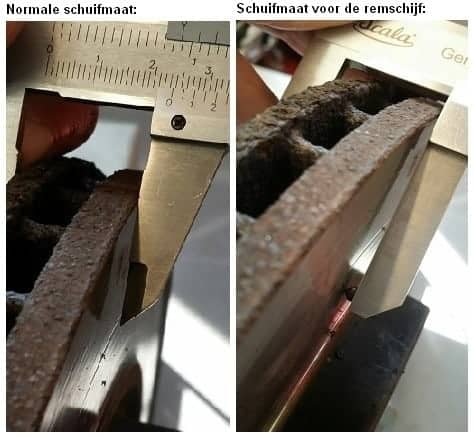
Between the two measuring jaws are lugs that are placed against the tread of the brake discs, i.e. the parts where the brake pads touch the brake discs. The projections protrude, so that the thicker (rust) edge of the disc is not bothered by the thicker (rust) edge during measurement. To move the vernier caliper over the rust edge, the vernier (which will be read later) can be moved. During the measurement, the locking screw must be tightened, so that the vernier can no longer move.
The picture shows such a caliper.
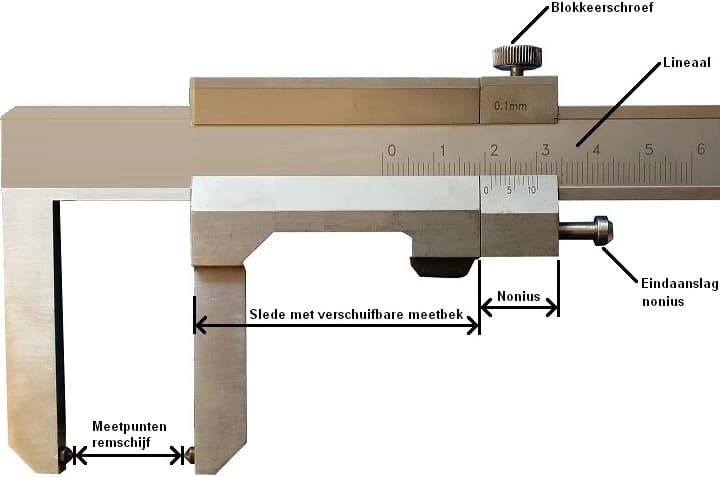
When measuring, the measuring jaws must be pressed against the brake disc with the cams (see image below). The vernier must be moved against the end stop, i.e. all the way to the right, until it cannot go any further. Then the locking screw must be tightened, so that the vernier can no longer slide back and forth on the ruler. At this point, the disc size can be taken from the brake disc. The measuring jaws can be moved to be moved over the (rust) edge because the vernier is blocked in the extreme position. The position of the measuring jaws has no influence on the stated vernier value on the ruler.
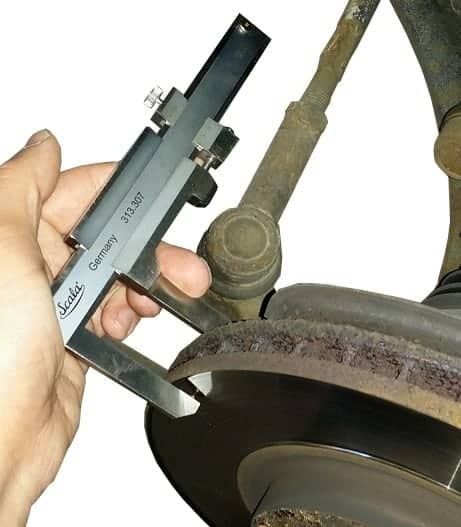
After the vernier caliper has been removed, the value of the vernier and ruler can be read. The image below is an enlargement of the measurement at the brake disc measured above. The indicated size is 21,2 mm.
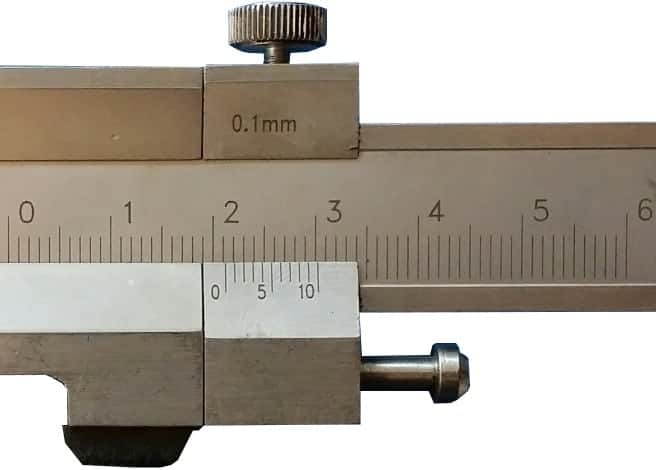
For the vehicle whose brake disc has been measured, the minimum brake disc thickness is 22,0 mm. The measured value, 21,2 mm, is therefore lower than the minimum value. The brake discs must therefore be replaced. If the measured value were higher than the minimum brake disc thickness, the brake discs would still be thick enough to mount a new brake pad set.
Short explanation about reading the vernier caliper:
There is a long line on the ruler to the left of the 2. This is the line of 2 cm, or 20 mm.
The 0 of the vernier is slightly past 21 mm. That means the size is slightly larger than 21mm, so there will be a number after the decimal point. To determine that number, it is necessary to look at which line the ruler and the vernier correspond to. That is (counting from 0) the second line, so the exact measured value is 21,2 mm.
On the page mechanical measuring tool More information about mechanical measurement is given.
Curved brake disc:
When the driver brakes the car hard, the parts of the braking system become very hot. The brake discs do reach temperatures of more than 300° Celsius during prolonged braking. If the driver then keeps the brake pedal depressed when the car is stationary, the brake pads are pressed against a stationary disc. The brake disc will cool down on one side; this means that the brake disc cools over the entire surface, except where the brake pads touch the brake disc.
Due to the temperature difference, the brake disc can deform a little, making it “crooked”. The steering wheel will then vibrate when the brake pedal is actuated. The vibration can also be so great that it can be felt throughout the car.
Another possibility in which warped brake discs are obtained is when driving through a puddle of water after braking for a considerable distance. The water that ends up on the brake disc can cause unilateral cooling, which can cause the brake disc to deform.
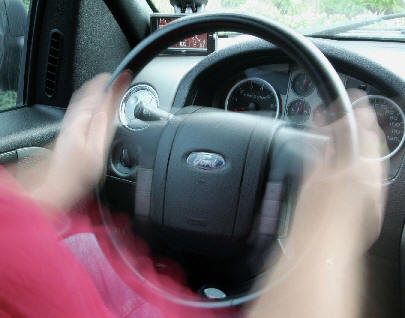
The next section describes how to measure the brake disc runout.
Measuring the brake disc runout:
The moment the steering wheel of the car vibrates during braking, there may be bent brake discs. The vibration is often already noticeable at low vehicle speeds. To rule out whether the vibration is not caused by other suspension components, the runout of the brake discs can be measured.
When measuring the runout of the brake disc, a mechanism with a magnet is mounted on a fixed part of the vehicle (for example the shock absorber). A micrometer is mounted at the end, with the needle placed against the brake disc. This can be seen in the image below.
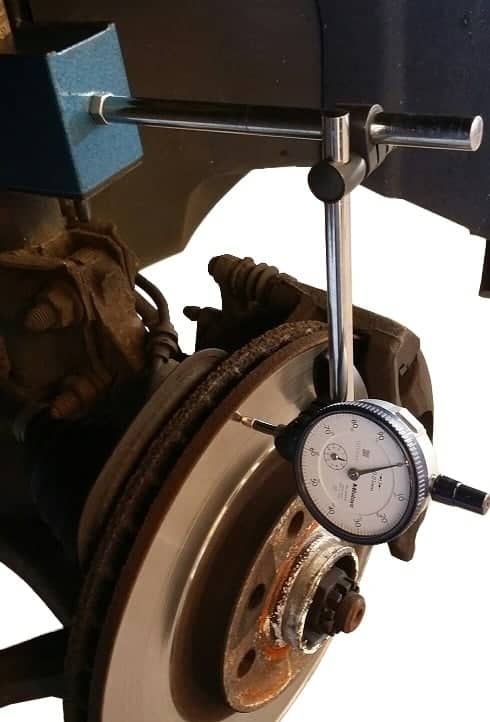
After the dial indicator has been set to 0 and the mechanism is securely mounted, the brake disc can be turned. The needle of the micrometer will indicate how far the brake disc moves in and out. The image below shows that at a certain point the micrometer reads 20. This 20 stands for 0,20 mm. For this vehicle, the factory data stated that the maximum permissible runout of the brake disc is 0,1 mm. In this case the runout is 0,1 mm more than allowed, so the brake disc is bent.
In some cases it happens that the wheel hub is also bent. To make sure that only the brake discs are causing the vibration, the brake disc can be removed from the hub and the same measurement can be made on the hub. If the needle of the micrometer also moves too far in that case, the hub, and thus also the wheel bearing, must be replaced together with the brake disc.
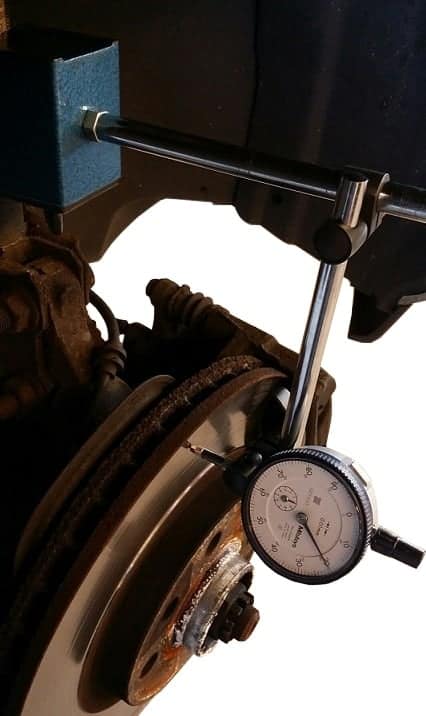
Related page:
